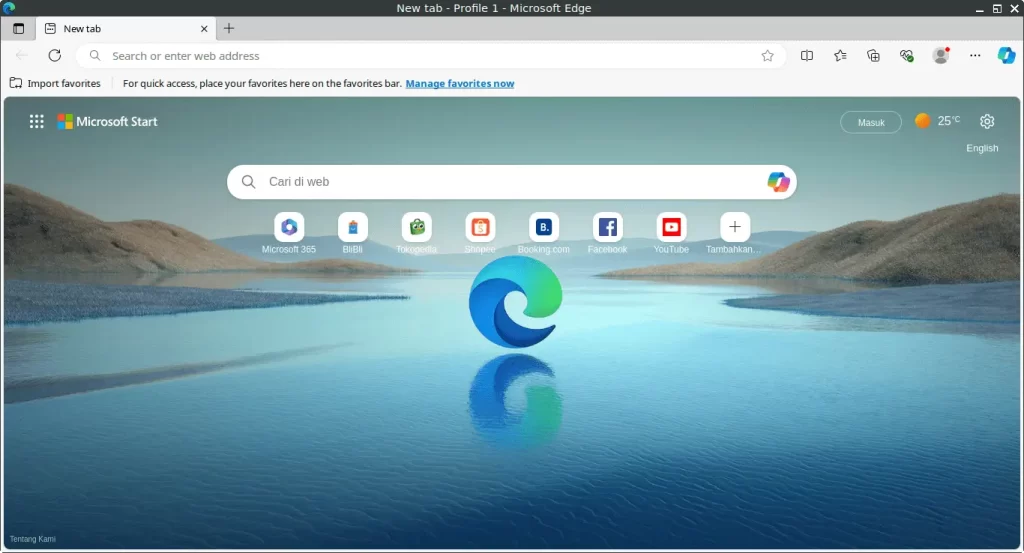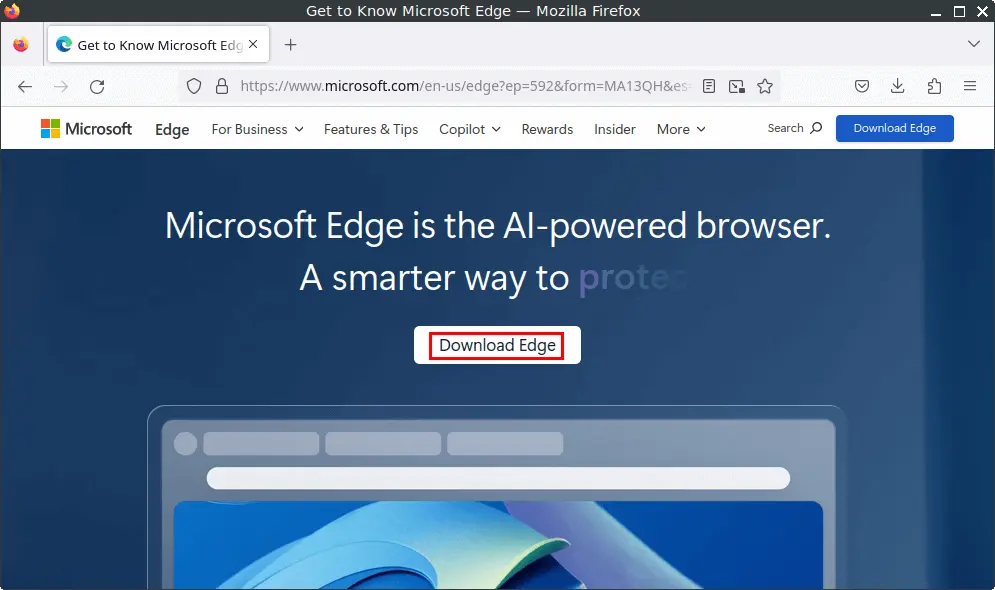Microsoft Edge is one of the most popular web browsers today, offering a fast, secure, and feature-rich browsing experience. It’s built on the Chromium engine — the same foundation used by Google Chrome — making it fully compatible with modern web standards and extensions. FunOS users who prefer Microsoft Edge for its performance, integration with Microsoft services, or cross-platform syncing can easily install it using the steps below. This guide will explain two methods to install Microsoft Edge on FunOS: using the official Microsoft repositories and by downloading the .deb package manually from Microsoft’s website.
What is Microsoft Edge?
Microsoft Edge is a web browser developed by Microsoft, first released in 2015 as the successor to Internet Explorer. In 2020, Microsoft rebuilt Edge using the Chromium open-source project, the same engine that powers Google Chrome, Brave, and Opera. This change significantly improved compatibility, performance, and access to a vast library of extensions from the Chrome Web Store.
Edge also comes with several advanced features such as built-in tracking prevention, vertical tabs, Collections (for organizing research and ideas), and Microsoft account synchronization — allowing bookmarks, history, and passwords to be shared across devices. On FunOS, Edge provides a modern, efficient alternative to Firefox ESR (the default browser) and can serve as the main or secondary browser depending on user preference.

How to Install Microsoft Edge on FunOS
There are two recommended ways to install Microsoft Edge on FunOS. The first is through Microsoft’s official repository — which provides automatic updates through the system’s package manager. The second method is by manually downloading and installing the .deb package.
Method 1: Installing from the Microsoft Repositories
This is the preferred method because it ensures that Microsoft Edge receives automatic updates when new versions are released.
Step 1: Open a Terminal
You can open a Terminal in any of the following ways:
- Click Menu in the left corner of the screen, then click Terminal
- Click the Terminal icon in the Tray
- Press Ctrl + Alt + T on your keyboard
Step 2: Update the Package List
Before installing any new software, update the package list to ensure you have the latest package information:
sudo apt updateStep 3: Install the Necessary Dependencies
Install the required tools for adding new repositories:
sudo apt install apt-transport-https curlStep 4: Add the GPG Key
Add Microsoft’s GPG key to verify the authenticity of packages:
curl -fSsL https://packages.microsoft.com/keys/microsoft.asc | gpg --dearmor | sudo tee /etc/apt/trusted.gpg.d/microsoft-edge.gpg > /dev/nullStep 5: Add the Repository
Add Microsoft’s Edge repository to your system’s sources list:
echo "deb [arch=amd64] https://packages.microsoft.com/repos/edge/ stable main" | sudo tee /etc/apt/sources.list.d/microsoft-edge.listStep 6: Update the Package List Again
After adding the repository, update the package list again so the new source is recognized:
sudo apt updateStep 7: Install Microsoft Edge
Now install Microsoft Edge (Stable version):
sudo apt install microsoft-edge-stableStep 8: Reload the Menu
After installation, reload the JWM menu so that Microsoft Edge appears:
- Click the Menu button in the lower-left corner.
- Click Reload menu.
Method 2: Using the .deb Package from Microsoft’s Official Website
This method is useful if you prefer a one-time manual installation without adding a repository.
Step 1: Download the Microsoft Edge .deb File
Visit the official Microsoft Edge download page:
https://www.microsoft.com/en-us/edge
Click Download Edge. Save the file in your Downloads directory.

Step 2: Open a Terminal
Open a Terminal using one of the following options:
- Click Menu in the left corner of the screen, then click Terminal
- Click the Terminal icon in the Tray
- Press Ctrl + Alt + T
Step 3: Navigate to the Downloads Directory
Move to the directory where the downloaded file is located:
cd ~/DownloadsStep 4: Update the Package List
Before installation, update the system package list:
sudo apt updateStep 5: Install Microsoft Edge
Install the downloaded .deb package:
sudo apt install ./microsoft-edge-stable_*.debStep 6: Remove the Downloaded .deb File
Once installation is complete, you can safely delete the installer file:
rm -f microsoft-edge-stable_*.debStep 7: Reload the Menu
Finally, reload the JWM menu to make Microsoft Edge appear:
- Click the Menu button in the lower-left corner.
- Click Reload menu.
Launching Microsoft Edge
After installation, you can launch Microsoft Edge directly from the FunOS menu.
- Click the Menu button in the lower-left corner of the screen.
- Navigate to the Internet section.
- Click Microsoft Edge to open the browser.
The first time you launch it, Edge may ask whether you want to make it your default browser and offer options to import data such as bookmarks and passwords from other browsers. You can choose to skip or configure these settings as desired.
Once launched, Microsoft Edge provides a clean, modern interface with smooth performance and excellent web compatibility. You can sign in with your Microsoft account to sync browsing data across devices, install Chrome extensions from the Chrome Web Store, and customize the start page, themes, and privacy settings according to your preferences.
How to Uninstall Microsoft Edge on FunOS
If you decide to remove Microsoft Edge from your system, you can uninstall it completely using the Terminal. Follow these steps carefully to ensure that all associated files are deleted.
Step 1: Open a Terminal
You can open a Terminal in one of these ways:
- Click Menu in the left corner of the screen, then click Terminal
- Click the Terminal icon in the Tray
- Press Ctrl + Alt + T
Step 2: Remove Microsoft Edge
To uninstall Microsoft Edge, run the following command:
sudo apt remove --purge microsoft-edge-stableStep 3: Remove Any Unused Dependencies
After uninstalling, remove leftover packages that are no longer needed:
sudo apt autoremove --purgeStep 4: Update the Package List
It’s good practice to refresh the package index after removing applications:
sudo apt updateStep 5: Remove User Data (Optional)
If you want to completely erase all user data (such as settings, cache, and browsing history), you can remove Microsoft Edge’s configuration directories:
rm -rf $HOME/.config/microsoft-edge
rm -rf $HOME/.cache/microsoft-edge
rm -rf $HOME/.cache/Microsoft/EdgeNote: This step is optional. Once removed, your browsing data cannot be recovered.
Step 6: Reload the Menu
To update the JWM menu and remove Microsoft Edge from the Internet section:
- Click the Menu button in the lower-left corner.
- Click Reload menu.
Conclusion
Microsoft Edge is a fast, modern, and secure browser that integrates seamlessly with web technologies and Microsoft services. On FunOS, it can be installed easily either through Microsoft’s official repositories — which ensures automatic updates — or by manually downloading the .deb package.
Edge’s Chromium foundation ensures compatibility with most websites and extensions, making it a powerful alternative or complement to the default Firefox ESR browser in FunOS. With its clean design, efficient performance, and optional Microsoft account synchronization, Edge offers a great browsing experience for both work and personal use.
If you ever decide to switch to another browser, uninstalling Microsoft Edge is just as simple, leaving your system clean and ready for other software.

Leave a Reply